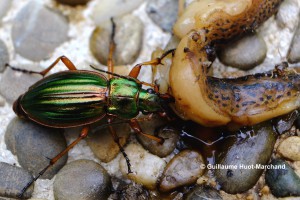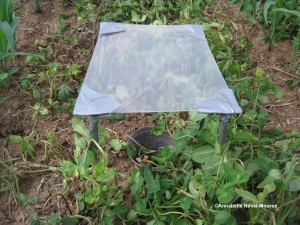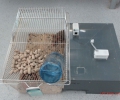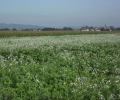The effects of vegetation cover on insects that are beneficial to crops: positive results!
21 septembre 2018Ground beetles, crawling insects from the Coleoptera family, inhabit cultivated fields and are invaluable allies for farmers in helping to deter crop pests.
Slug eaters!
Large ground beetles, which can reach 25 mm in length, such as the Pterostichus melanarius, as well as the smaller Amara similata, latch on to slugs with their oversized jaws, perforating the tegument of the molluscs. During the breeding season, female ground beetles consume twice as many slugs as males. Other ground beetles survive on aphids and the seeds of weeds. According to literature on the subject, no-plough systems with vegetation cover may be more favourable to ground beetles and may make them more effective in deterring crop pests.
A field study conducted as part of the LIFE Alister programme
A field study on these beneficial insects was carried out in 2017 on research plots of the LIFE Alister project to establish whether techniques that are favourable to the hamster have any positive effects on biodiversity.
Insect traps were set up on six plots of corn, which were measured every week: two of the plots used a plough farming system with no cover, whilst four used a no-till farming system with a cover of clovers planted the previous year and kept alive until the sowing of the corn. Traps were also set up on two plots of wheat: one of the plots was a conventional plot with a catch crop sown at the end of August, whilst the other plot had a cover of multi-species vegetation, planted two weeks after the wheat harvest. The field study was carried out on 30 May to 1 August for corn, and until 29 September for wheat. In total, 3,557 ground beetles belonging to 36 different species were collected and identified by the Orléans Environmental Entomology Laboratory.
Vegetation cover considerably favourable to ground beetles
In the case of both corn and wheat, a higher number of individuals and species were found in plots with vegetation cover. In corn, 18 different species of ground beetle were identified in the control plots with no cover, and 30 in the plots with cover! Plots with cover were also found to contain three times the number of individuals (all species combined) as the control plots. In wheat, the differences were less marked in terms of the number of species, but there were a third more individuals in the plot with earlier vegetation cover than in the control plot.
Although its primary goal is essentially to capture residual nutrients and to prevent nitrates from leaching into the soil, vegetation cover also helps to create a humid microclimate and to reduce differences in temperature at different times of day, especially in the case of hot summer temperatures. Vegetation cover houses varying sizes of ground beetles that feed on prey living in the foliage above the soil, such as insects, slugs, aphids and snails; these are allies that should not be underestimated!






